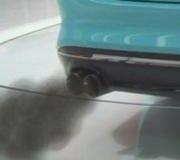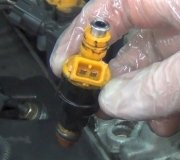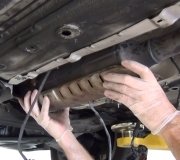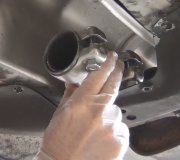Welcome back:
Here are the directions for checking fuel pressure specific to your vehicle. The attached pics correlate with these directions.
2002 Toyota Camry SE Sedan L4-2.4L (2AZ-FE)
Component Tests and General Diagnostics
Vehicle Powertrain Management Fuel Delivery and Air Induction Fuel Pump Fuel Pressure Testing and Inspection Component Tests and General Diagnostics
COMPONENT TESTS AND GENERAL DIAGNOSTICS
ON-VEHICLE INSPECTION
1. CHECK FUEL PRESSURE
pic 1
a. Prepare for inspection.
1. Purchase the new fuel tube and take out the fuel tube connector from its pipe.
HINT: Part No.23901-28130
b. Work for prevent gasoline from spilling out.
Pic 2
c. Remove the fuel pipe clamp No.1 from the fuel tube connector.
Pic 3
d. Disconnect the fuel tube connector from the fuel pipe while pinching part A with fingers as shown in the illustration.
CAUTION:
- Perform disconnecting operations of the fuel tube connector (quick type) after observing the precautions.
- As there is retained pressure in the fuel pipe line, prevent it from splashing inside the engine compartment.
Pic 4
e. Install SST (pressure gauge) as shown in the illustration by using SST and fuel tube connector.
SST 09268-41047 (90467-13001, 95336-08070), 09268-45012 (09268-41250)
f. Wipe off any splattered gasoline.
G. Reconnect the negative (-) terminal cable to the battery.
H. Connect the hand-hand tester to the DLC3.
I. Measure the fuel pressure regulator.
Fuel pressure:
304 - 343 kPa (3.1 - 3.5 kgf/sq. Cm, 44 - 50 psi)
If pressure is high, replace the fuel pressure regulator.
If pressure is low, check the fuel hoses and connections, fuel pump, fuel filter and fuel pressure regulator.
J. Disconnect the hand-held tester from the DLC3.
K. Start the engine.
L. Measure the fuel pressure at idle.
Fuel pressure:
304 - 343 kPa (3.1 - 3.5 kgf/sq. Cm, 44-50 psi)
m. Stop the engine.
N. Check that the fuel pressure remains as specified for 5 minutes after the engine has stopped.
Fuel pressure: 147 kPa (1.5 kgf/sq. Cm, 21 psi) or more If pressure is not as specified, check the fuel pump, pressure regulator and/or injectors.
O. After checking fuel pressure, disconnect the negative (-) terminal cable from the battery and carefully remove the SST and fuel tube connector to prevent gasoline from splashing.
P. Reconnect the fuel tube (fuel tube connector).
CAUTION: Perform connecting operations of the fuel tube connector (quick type) after observing the precautions.
2. CHECK FUEL PUMP OPERATION AND FUEL LEAK
a. When using hand-held tester
1. Connect the hand-held tester to the DLC3.
2. Turn the ignition switch ON and hand-held tester main switch ON.
NOTE: Do not start the engine.
3. Select the active test mode on the hand-held tester.
4. Please refer to the hand-held tester operator's manual for further details.
Pic 5
b. When not using hand-held tester
1. Remove the circuit opening relay.
2. Using a service wire connect terminals FP and +B of the relay block.
NOTE: Pay due attention to the terminal connecting position to avoid a malfunction.
3. Turn the ignition switch ON, and check that the fuel pump operates.
NOTE: Do not start the engine.
C. Check that there are no fuel leaks after doing maintenance anywhere on the fuel system.
_________________________________________
As for the regulator, here is what my manual says.
" A compact fuel pump in which a fuel filter and pressure regulator are integrated in the module fuel pump assembly has been adopted."
Let me know if any of this helps or if you have questions.
Joe
Images (Click to make bigger)
Thursday, October 10th, 2019 AT 6:47 PM








